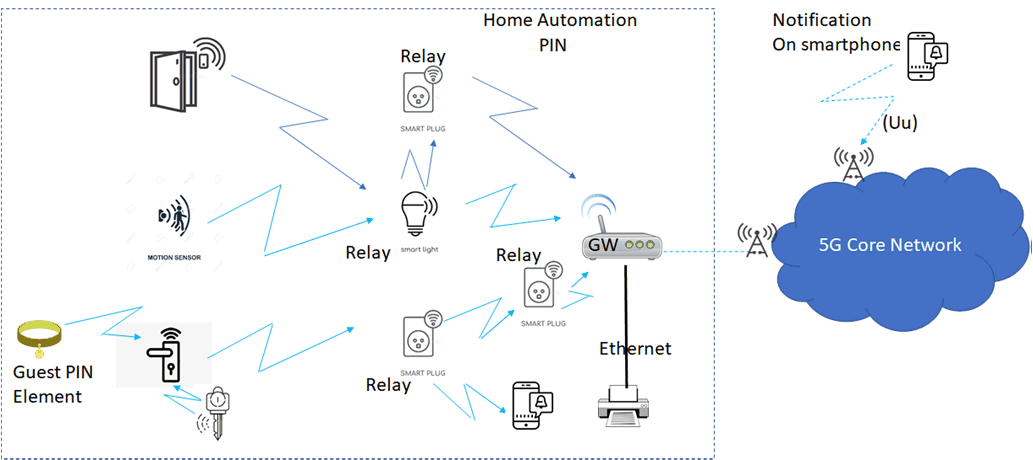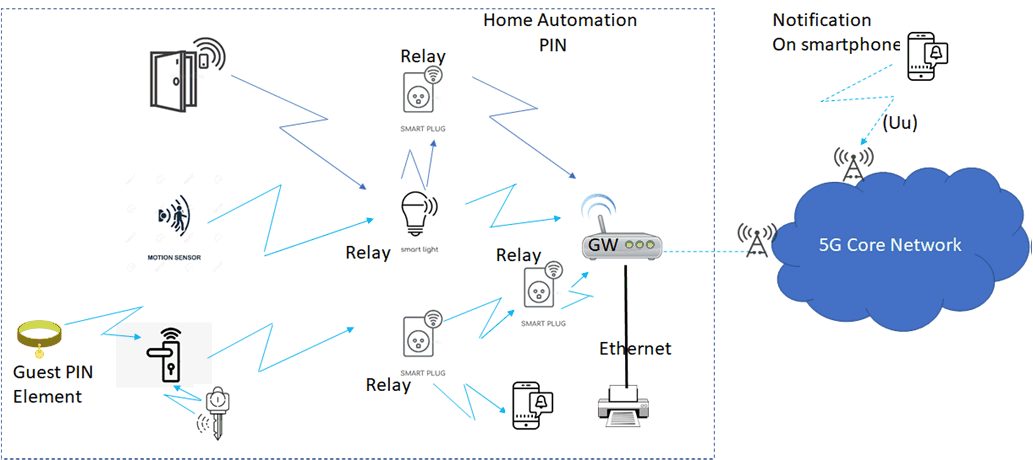Content for TR 22.859 Word version: 18.2.0
1 Scope
2 References
3 Definitions and abbreviations
3.1 Definitions
3.2 Abbreviations
4 Overview
...
...
1 Scope p. 7
The present document is aiming at documenting potential new use cases and service requirements to enhance 5GS for the support of Personal IoT networks (PINs), including when the PIN is connected to 5GC.
2 References p. 7
The following documents contain provisions which, through reference in this text, constitute provisions of the present document.
- References are either specific (identified by date of publication, edition number, version number, etc.) or non-specific.
- For a specific reference, subsequent revisions do not apply.
- For a non-specific reference, the latest version applies. In the case of a reference to a 3GPP document (including a GSM document), a non-specific reference implicitly refers to the latest version of that document in the same Release as the present document.
[1]
TR 21.905: "Vocabulary for 3GPP Specifications".
[2]
TS 22.261: "Service requirements for the 5G system".
[3]
TS 22.101: "Service principles".
[4]
Christiane Attig, Nadine Rauh, Thomas Franke, & Josef F. Krems (May 2017) "System Latency Guidelines Then and Now - is Zero Latency Really Considered Necessary? https://www.researchgate.net/publication/317801643_System_Latency_Guidelines_Then_and_Now_-_Is_Zero_Latency_Really_Considered_Necessary/link/5ae18fc4458515c60f662370/download
[5]
TS 22.278: "Service requirements for the Evolved Packet System (EPS); Stage 1".
[6]
TR 22.858: " Study of Enhancements for Residential 5G; Stage 1".
[7]
TS 22.115: "Service aspects; Charging and billing".
[8]
TS 22.228: "Service requirements for the IP multimedia core network subsystem".
[9]
ZigBee® Specification https://zigbeealliance.org/wp-content/uploads/2019/11/docs-05-3474-21-0csg-zigbee-specification.pdf
[10]
Z-Wave® Specifications https://z-wavealliance.org/z-wave-specifications/
[11]
2020 US Census https://www.census.gov/construction/chars/highlights.html#:~:text=The%20median%20size%20of%20a,house%20was%202%2C301%20square%20feet .
[12]
Minimum provision of electrical Socket-outlets in the home https://www.electricalsafetyfirst.org.uk/media/1204/guidance-on-minimum-provision-socketsv2.pdf
[13]
David Wilson Homes https://www.dwh.co.uk/advice-and-inspiration/average-house-sizes-uk/#:~:text=Average%20UK%20house%20size%3A%20656%20sq .
[14]
National Electrical Code 70® https://www.nfpa.org/codes-and-standards/all-codes-and-standards/list-of-codes-and-standards/detail?code=70
[15]
TR 22.104: "Service requirements for cyber-physical control applications in vertical domains; Stage 1".
[16]
[17]
USATODAY 17th Dec 2020 https://www.usatoday.com/story/tech/columnist/komando/2020/12/17/amazons-sidewalk-shares-internet-connection-you-may-want-opt-out/3887227001/
[18]
[19]
TS 23.548: "5G System Enhancements for Edge Computing; Stage 2"
[20]
TS 23.558: "Architecture for enabling Edge Applications (EA)"
3 Definitions and abbreviations p. 8
3.1 Definitions p. 8
For the purposes of the present document, the terms and definitions given in TR 21.905 and the following apply. A term defined in the present document takes precedence over the definition of the same term, if any, in TR 21.905.
direct device connection:
PIN Element with Management Capability:
See definition in TS 22.261.
direct network connection:
See definition in TS 22.261.
Guest PIN Element:
Is a PIN Element that is a member of one PIN (Home PIN) and can access any other PIN, if allowed to by that PIN to communicate with the Home PIN.
IoT device:
See definition in TS 22.261.
PIN direct connection:
the connection between two PIN Elements without any 3GPP RAN or core network entity in the middle.
PIN Element:
UEs or non 3GPP devices that can communicate within a PIN.
PIN Element with Gateway Capability:
a UE PIN Element that has the ability to provide connectivity to and from the 5G network for other PIN Elements that use PIN direct connections.
A PIN Element with PIN management Capability has capability to manage the PIN.
Personal IoT Network:
A configured and managed group of at least one UE and one or more PIN Elements or UEs that are (pre-)authorised to communicate with each other.
PIN-User:
The person who owns the PIN.
3.2 Abbreviations p. 9
For the purposes of the present document, the abbreviations given in TR 21.905 and the following apply. An abbreviation defined in the present document takes precedence over the definition of the same abbreviation, if any, in TR 21.905.
PIN
Personal IoT Network
UPnP
Universal Plug and Play
DNLA
Digital Living Network Alliance
4 Overview p. 9
IoT capabilities have been designed for devices that communicate using the traditional cellular network, including battery constrained devices where it is expected that the battery should last in the order of years. Recently standards have been extended to support more vertical IoT devices for factory based, audio visual, medical, mission critical and vehicular solutions. In some contexts, e.g. factory based solutions the concept of a private network has been introduced, this has the added benefit for devices that generate very little user plane traffic (e.g. sensors etc.) the traditional cellular operator might not have to dedicate resources to them in the network and the traffic can stay within the local "factory (private network) environment". There are 2 consumer segments that have similar traffic characteristics where private networks provide an advantage, where communications are predominately within the constraints of a localized IoT network:
- Wearable devices;
- Home automation
a)

An example of a home automation PIN can be seen in Figure 4-1 where there are a number of devices in the home that either communicate directly with the hub or indirectly via a relay to the hub. A smartphone in the 5G system can receive notifications regarding events (e.g. door opens) from the home automation PIN.

b)

In summary, it is considered beneficial for 3GPP specification to address 5G system support of different use cases for PINs.
Wearables can use a multitude of different access technologies, battery life can in some situations be severely constrained just by the physical dimension limitations e.g. glasses frames, earbuds, blood pressure monitor, pacemaker and rings. Space is also at a premium, capabilities are limited (memory, processing power, even USIM functionality might not be available). Location requirements on wearable devices, especially those with Uu interfaces can contribute to battery drain. Earbuds / Rings are very small, even an ESIM chip takes up valuable space, battery consumption and adds weight to the device. Figure 4-2 shows two wearable networks, one where all the devices communicate via the smartphone and another where glasses act as a relay for smart earbuds.
